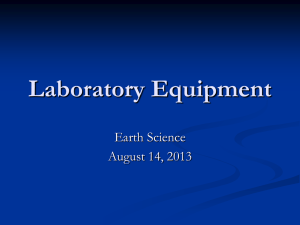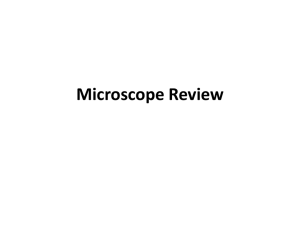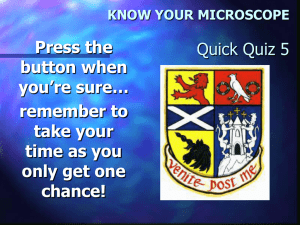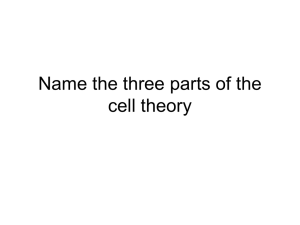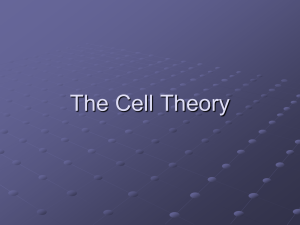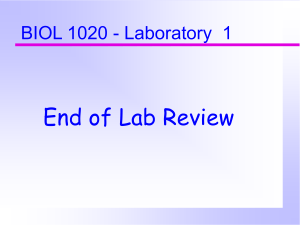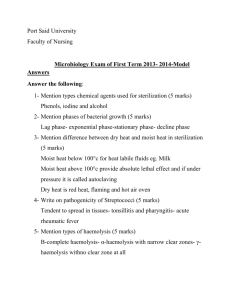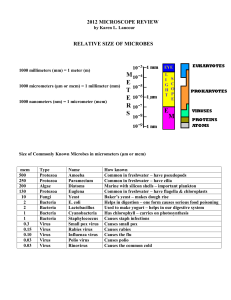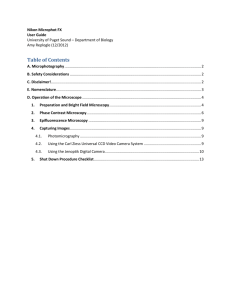MICROSCOPY
advertisement
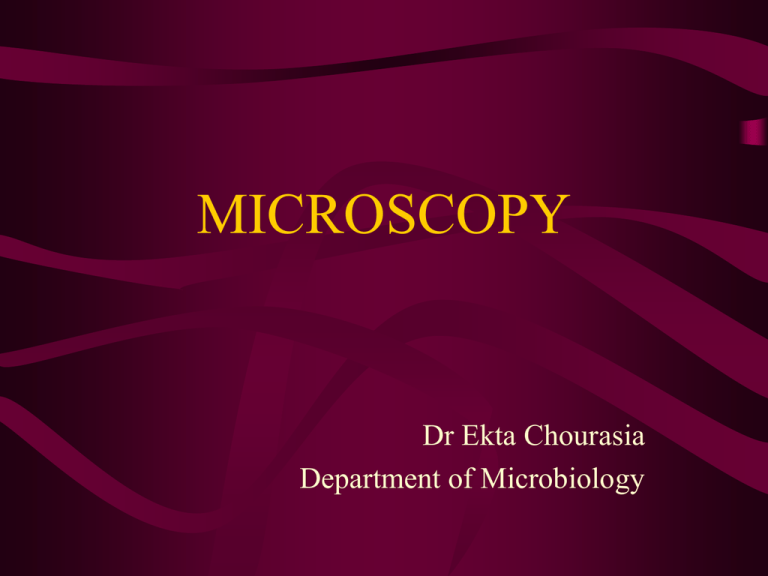
MICROSCOPY Dr Ekta Chourasia Department of Microbiology MICROSCOPY • Microscope invented by Antony Van Leeuwenhoek in 17th century. • Required for the morphological study of microorganisms. • USES - to magnify the image. - to achieve maximum resolution. - to provide sufficient contrast for observation Resolution : the extent to which details in the magnified object are maintained. Resolving Power (RP) : the smallest distance by which 2 points can be separated and still be observed as 2 distinct / different points. RP (eye) – 200 µm RP (visible light) – 300 nm RP (electron microscope) – 0.1 nm Types of Microscopes • Optical or light microscope - Simple - Compound • Phase contrast microscope • Dark field (dark ground) microscope • Fluorescent microscope • Electron microscope Optical (Light) Microscope Optical (Light) Microscope • Principle : when visible light passes through the specimen & then through a series of lenses, the light gets reflected in such a manner that it results in magnification of the organisms present in the specimen. • Magnification = objective x eyepiece • To achieve maximum resolution with 1000x magnification, oil immersion must be used • Oil prevents dispersion of light after light passes through the specimen. • Images produced have very little contrast, therefore dyes are used to stain the specimen. Phase Contrast Microscope • Improves the contrast • Makes the structures within the cells evident that differ in their thickness or refractive index. • Also, differences in the refractive index of cell & the surrounding medium make them clearly visible. Phase Contrast Microscope-Principle • When beams of light pass through the specimen, it is partially scattered by the microbial cells or cell structures. Scattering depends on the thickness/ refractive indices of various structures • High refractive index - more scattering of light. A scattered light also loses its velocity when travelling through the object and is not in phase with the unaltered light. Therefore appears as dark spot whereas the unobstructed light appears as bright spot. These differences in the intensity provide light & dark contrast to the image. Advantage : since staining is not involved, live organisms can be observed. Dark Field (Ground) Microscope • Specimens appear as bright images against a nearly black background. • Dark field condenser with a central circular stop – does not allow light to directly fall on the specimen. • Light passes only around the edges of the condenser. • Light rays which hit the object in the specimen are deflected upwards into the objective for visualization, rest will not enter and give a dark background. Spirochetes under dark ground illumination Uses of Dark Field microscopy • Very useful in finding extremely small, unstained and / or moving objects. • Organelles like cilia, flagella, vacuoles and cell nuclei can be clearly seen. Fluorescent Microscope • Microorganisms or tissue cells are stained with dyes or compounds called fluorochromes. • Examined under microscope with ultra – violet radiation instead of visible light. • They convert light of shorter (UV) wavelength into visible light and so become luminous – Fluoresce. • Wavelengths absorbed & emitted are specific for specific fluorochromes. Fluorochromes • • • • Acridine orange : Orange Auramine-Rhodamine : Yellow Calcofluor white : White Fluorescein Isothiocyanate (FITC) : Green Modification of Fluorescent Microscope • Immunofluorescence : Antibodies labeled with fluorochrome used to specifically stain a particular bacterial species. • Uses of IF : viruses, direct examination of C.trachomatis, B.pertussis Electron Microscope • Invented by Knoll & Ruska in 1936. • Uses electrons in place of light. • Electrons are focussed by electromagnetic field. • Image is formed on a fluorescent screen or is taken on a photographic material. • Resolving power is 100,000 times more than light microscope. Types of EM • 2 types : Transmission EM ( TEM ) Scanning EM ( SEM ) SEM allows the study of cell surfaces with greater contrast & higher resolution than TEM. • Disadvantages : Only dead & dried objects can be examined, since the medium is vacuum. Cell morphology is distorted. • Uses : for viruses, microbes less than 0.1 to 0.2.


